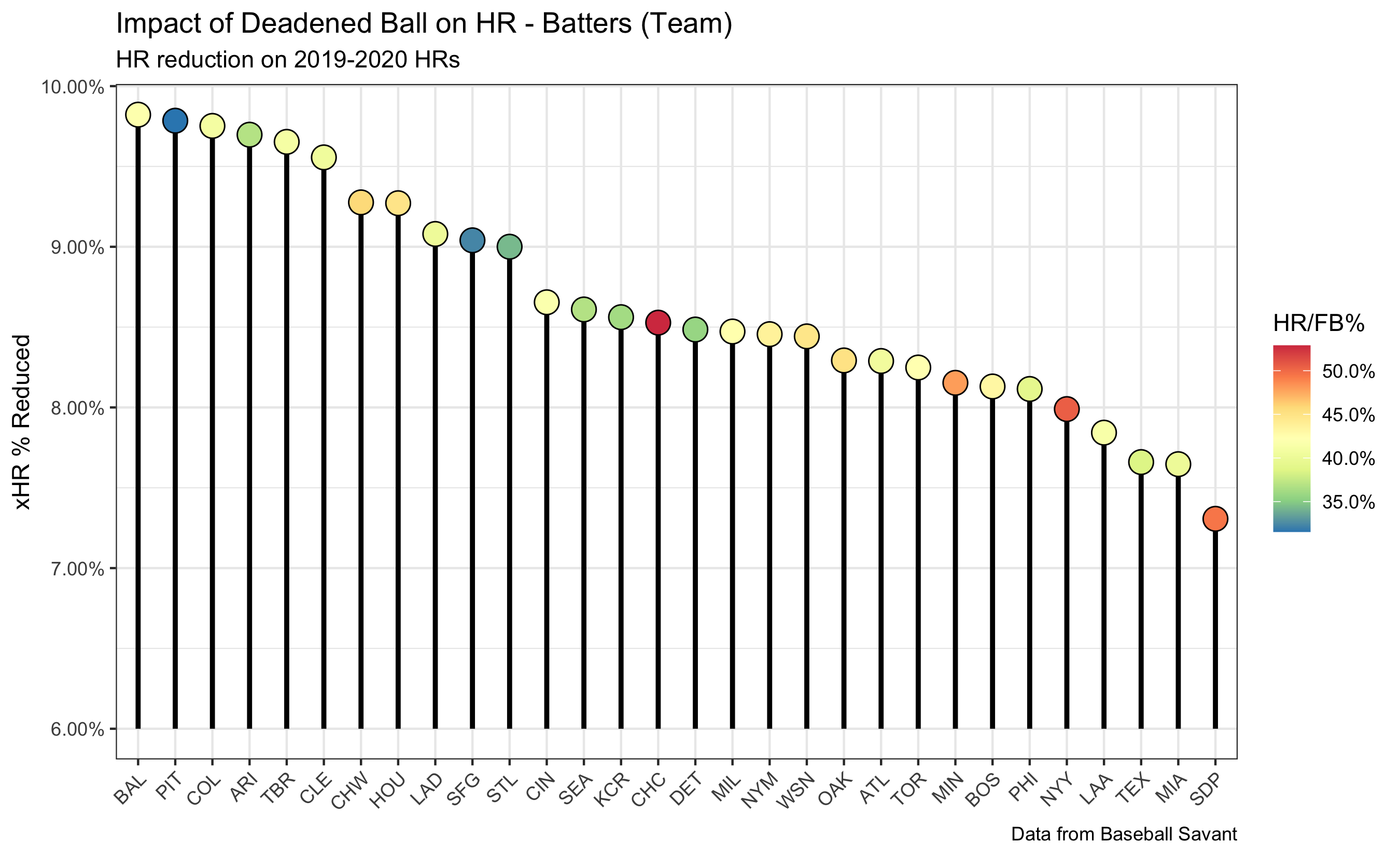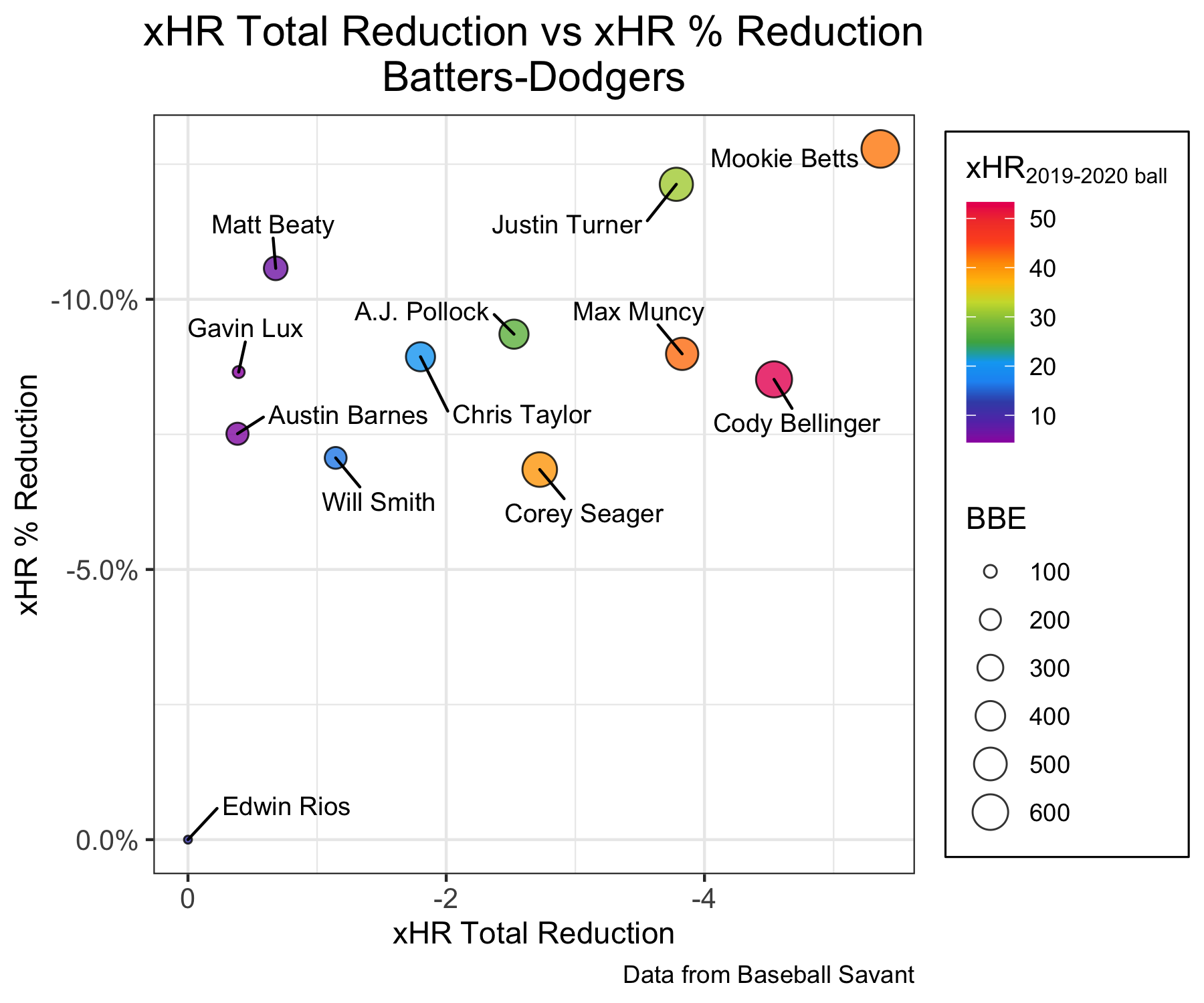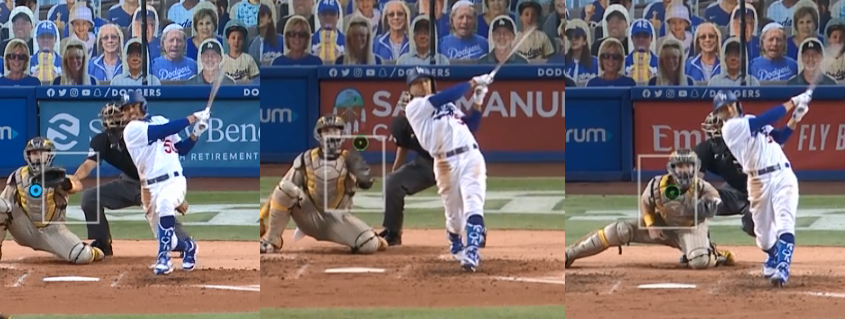Last week I published an article with Baseball Prospectus detailing a probabilistic model I built to predict the effects of a deadened ball on hitters and pitchers across the majors. The article took a broad look across MLB, without examining many individual players in detail. Here we’ll have the opportunity to focus on Dodgers hitting, specifically. How might the team’s offense as a whole be impacted relative to other teams? Who on the team is a deadened ball affecting the most? Why? Is there anything they can do to mitigate the effects? We’ll explore each of these questions.
——
First allow me to (somewhat) briefly explain the model as well as its limitations. The concept is very similar to expected batting average (xBA). Each batted ball event has certain qualities that make it more or less likely to result in a hit, most notably, those qualities are exit velocity (the speed of the ball of the bat), launch angle (the angle the ball projects into the air) and spray angle (left, center, right field, etc.). Those same batted ball qualities can be used to compute home run probability (xHR). If the construction of the ball changes from season to season, the same exit velocity, launch angle and spray angle will have different home run probabilities in different years.
In 2019, the ball was famously “juiced” relative to 2018. It was “juiced” in 2020 as well, just not quite as juiced as 2019. So compared to the 2019 and 2020 baseballs, the 2018 baseballs were deadened. What if we took the 2019-2020 batted ball data, then ran it through an xHR model built on the 2018 ball? That’s exactly what I did. This allows us to estimate the number of home runs hit if every ball in 2019-2020 was replaced with the ball used in 2018, effectively simulating the effect of deadening the ball. Note: This model only allows for us to make estimates on players who had major league plate appearances in 2019-2020.

The Dodgers 2021 roster would have lost 9.08% of their 2019-20 home runs with a deadened ball. That’s 9th most in the majors. Importantly, it’s not that every member of the 2021 Dodgers is projected to lose 9.08% of their home runs. The effect on each hitter will depend on the quality of their contact. Some will be more resilient to a deadened ball, because of power or bat angle, while others will be more vulnerable.

In the graph above, I’m only including the 12 players on the Dodgers 2021 roster with at least 5 home runs over the last two seasons. I’m plotting the total 2019-20 home runs predicted to be lost (x-axis) as well as the percentage of total HRs lost (y-axis) from a deadened ball. Below I’ll discuss a few individual players in greater depth to examine why the deadened ball is projected to impact them the way it does.
——
Mookie Betts is a prolific hitter. Although he doesn’t hit for incredible power, he makes quite good contact quite often. This allows him to accumulate respectable home run totals over a season. Deadening the ball, however, will result in an outsized number of the fly balls that went over the fence in 2019-2020, becoming fly outs.
In the plot below, the background represents the relationship between exit velocity and launch angle and home run probability, xHR, for both the 2019-2020 ball as well as the deadened ball. The more red, the higher the xHR. Each dot is a Mookie fly ball with an xHR2019-20 ball of at least 10%. The arrow direction represents spray angle. If it’s tilted to the left, the ball was hit to left field. Straight up to center field, etc. The color of the arrow is the xHR% boost from pulling the ball.
As you can see, Mookie hits most of his fly balls with exit velocity and launch angle that is most affected by a deadened ball. He also doesn’t have a strong proclivity for pulling the ball, which is good for hitting to all fields, but does compound the effects of deadening the ball. Despite the xHR model, I’m not actually worried about Mookie. Our model for the deadened ball is the 2018 ball and we all know how remarkable Mookie was that season. He’s more than toolsy enough to adjust.

You might have noticed that Edwin Rios is projected to lose 0 home runs from a deadened ball. Yup. That’s what the model actually says. He crushes the ball. He also pulls the ball. Although Rios makes quality contact less than someone like Mookie, when his contact is good, it is truly phenomenal.

Justin Turner hit fewer home runs than Mookie, but his batting profile is similar. You can see a lot of batted balls go from being in the red region of the xHR map (high home run probability) to the yellow-green region (low home run probaility).

Although Cody Bellinger is set to lose the second most home runs on the team, he hit so many to begin with, it’s not a substantial percentage loss. As you can see below Bellinger hits a lot of fly balls in the deeper red zone.

Below you’ll find xHR reduction graphs for the other eight batters.








The graph for each player tells its own story. Some guys aren’t affected much at all. Some guys could and maybe should pull the ball more. Some simply hit too many balls at inefficiently high or low angles. Some simply don’t hit for much power. In any case, the more opportunities a hitter has, the more the effect of a deadened ball will accumulate, stealing home runs from the player.
——
As much as a deadened ball can hurt hitters, it can also help pitchers. Next week we’ll dig into which Dodgers pitchers stand to benefit from a dented ball.
Spoiler: Some of the best Dodgers pitchers are projected to benefit quite a lot.
 Dodgers Digest Los Angeles Dodgers Baseball Blog
Dodgers Digest Los Angeles Dodgers Baseball Blog
